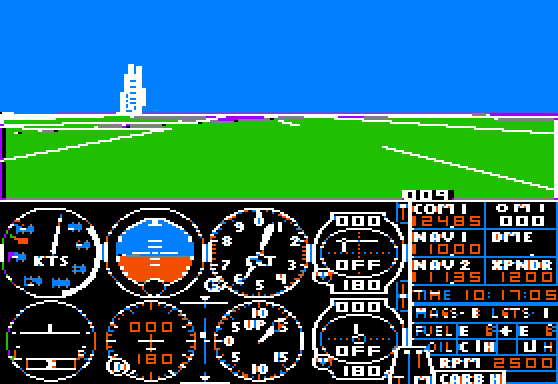subLOGIC Flight Simulator II for Apple II
Apple IIsubLOGIC Flight Simulator II v 1.0 (1983 by Bruce Artwick)
Game controls in browser
Show Controller & SystemClick on play Apple II game now button first to load the game and start emulator. Controls:
subLOGIC Flight Simulator II
Online version of subLOGIC Flight Simulator II for Apple II. SubLOGIC Flight Simulator II is second generation Flight Sim for Apple II, Commodore 64 and Atari 800. This version, like the Microsoft release, did away with wireframe graphics for solid colors, and featured real-world scenery...
Game details
Other platforms online
subLOGIC Flight Simulator II is currently playable only in version for Apple II.51%
rating (15 users voted)
Apple II Computers
Online emulated version of subLOGIC Flight Simulator II was originally developed for the Apple ][ (Apple //),
a family of home computers, one of the first highly successful mass-produced microcomputer products, designed primarily by Steve Wozniak,
manufactured by Apple Computer (now Apple Inc.), and launched in 1977 with the original Apple II.
The Apple II became one of several recognizable and successful computers during the 1980s and early 1990s, although this was mainly limited to the US.
Through 1988, a number of models were introduced, with the most popular, the Apple IIe, remaining relatively unchanged into the 1990s.
All the machines in the series, except the //c, shared similar overall design elements. The motherboard held eight expansion slots and an array of RAM sockets
that could hold up to 48 kilobytes. Over the course of the Apple II series' life, an enormous amount of first- and third-party hardware was made available to extend
the capabilities of the machine. The //c was designed as a compact, portable unit, not intended to be disassembled, and could not use most of the expansion hardware
sold for the other machines in the series.
All machines in the Apple II series had a built-in keyboard, with the exception of the IIgs which had a separate keyboard.
Apple IIs had color and high-resolution graphics modes, sound capabilities and a built-in BASIC programming language.


